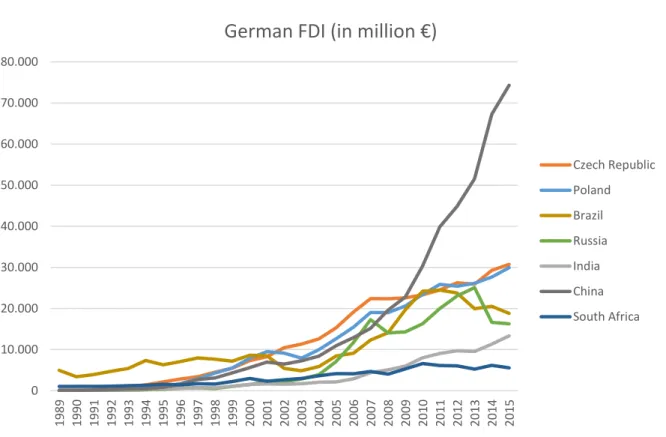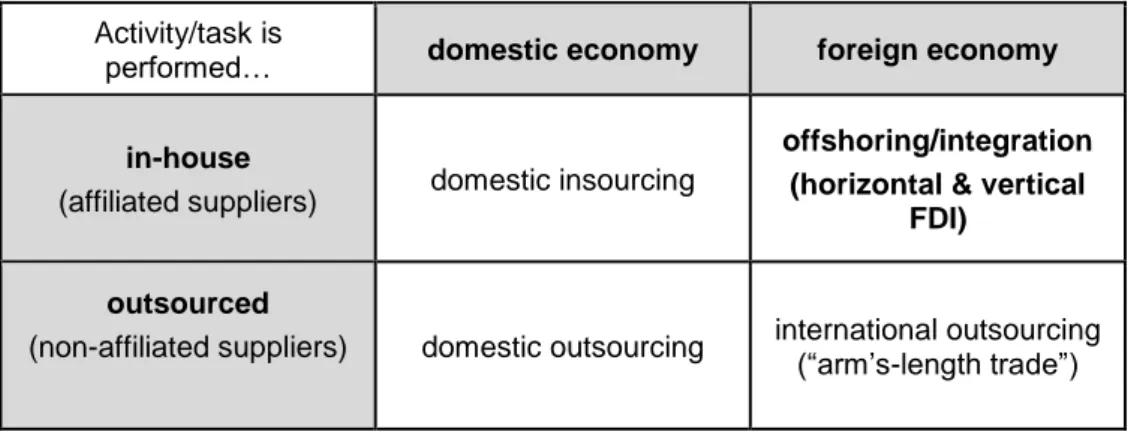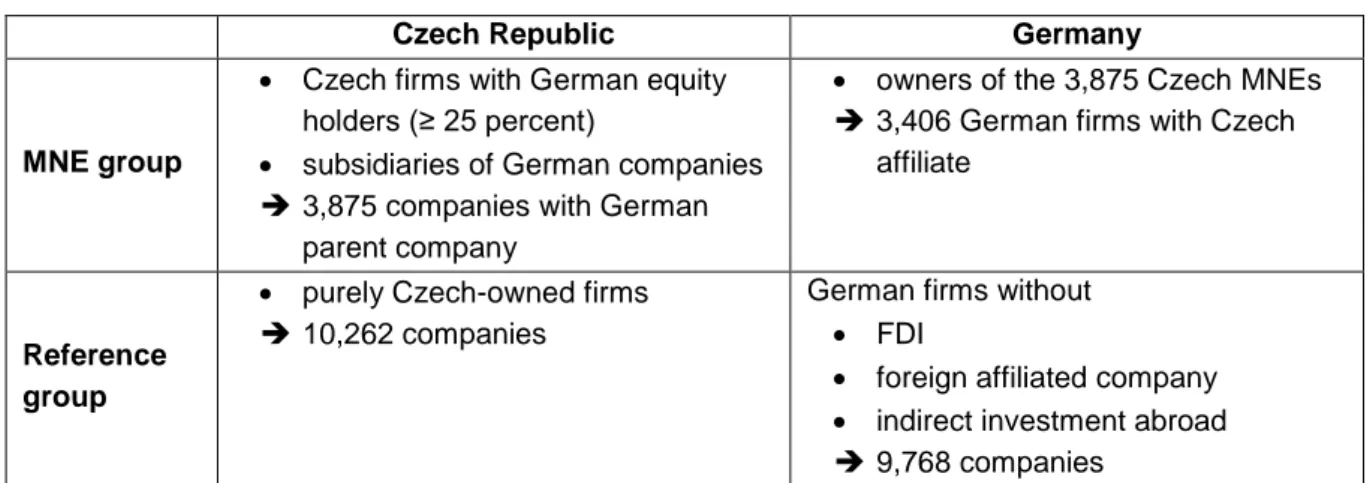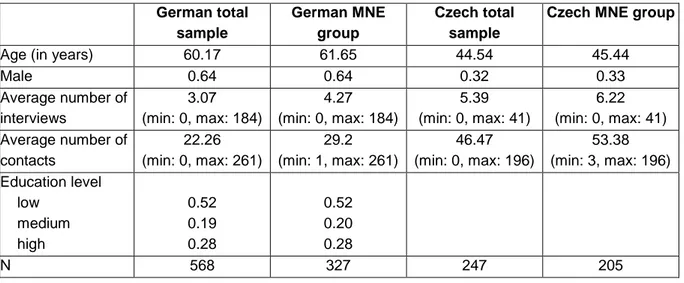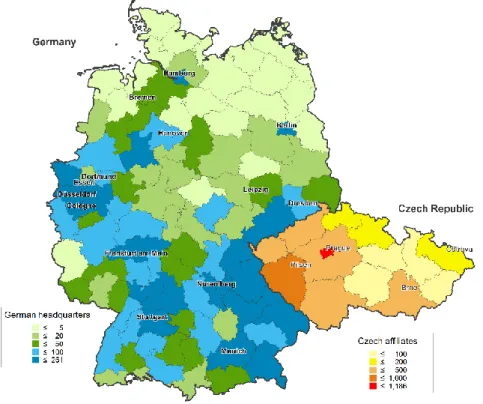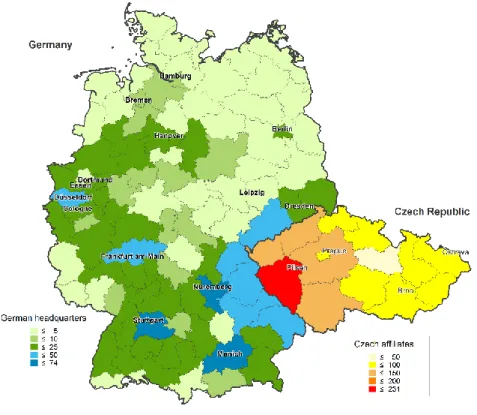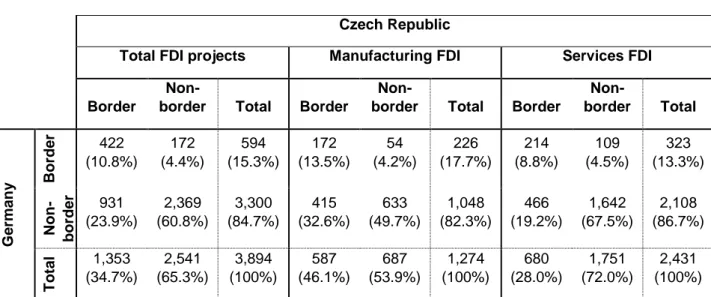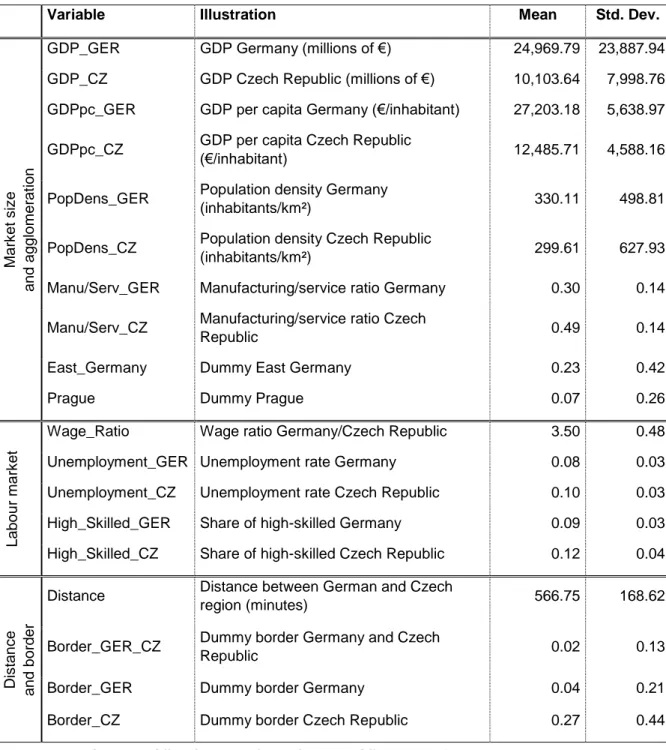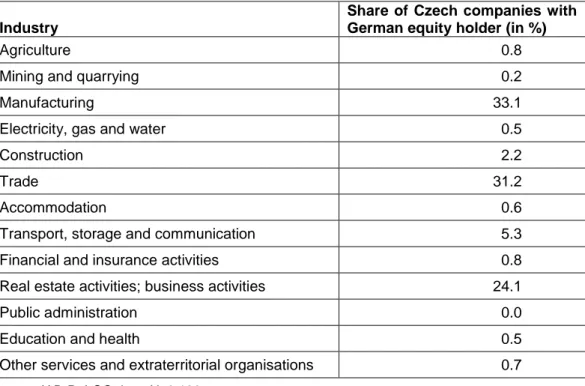German Foreign Direct Investment in the Czech Republic – An Analysis of Regional Determinants and
Investment Motives using the IAB-ReLOC Data
Dissertation zur Erlangung des Grades eines Doktors der Wirtschaftswissenschaft
eingereicht an der Fakultät für Wirtschaftswissenschaften der Universität Regensburg
vorgelegt von: Veronika Hecht
Berichterstatter: Prof. Dr. Dr. h.c. Joachim Möller Prof. Dr. Lutz Bellmann
Tag der Disputation: 29.01.2019
1
Table of content
Danksagung ... 4
1. Introduction ... 5
2. Research background ... 11
2.1 Globalisation and FDI ... 11
2.2 Regional distribution and location choice of FDI ... 13
2.2.1 Agglomeration economies ... 13
2.2.2 Labour market issues ... 14
2.2.3 Distance and border region features ... 15
2.2.4 Further location factors ... 16
2.2.5 Differences in location choice with respect to investment characteristics ... 17
2.3 Firm heterogeneity and FDI ... 18
3. Unit nonresponse at the firm level: a cross-border analysis using the IAB-ReLOC data ... 23
3.1 Introduction ... 24
3.2 The IAB-ReLOC data ... 25
3.2.1 Definition of research unit ... 26
3.2.2 Identification of research units ... 27
3.2.3 IAB-ReLOC survey ... 27
3.2.4 ReLOC linkage ... 29
3.3 Unit nonresponse analysis ... 29
3.3.1 Unit nonresponse: definition ... 30
3.3.2 Explanatory variables ... 32
3.3.2.1 Firm specific characteristics ... 32
3.3.2.2 Interviewer characteristics ... 33
3.3.2.3 Characteristics of the FDI project ... 34
3.3.3 Estimation method ... 37
3.3.4 Estimation results ... 38
3.4 Conclusion ... 47
4. Regional determinants of German FDI in the Czech Republic: new evidence on the role of border regions... 49
4.1 Introduction ... 50
4.2 Conceptual background and research questions ... 51
4.3 Data and descriptive statistics ... 53
4.3.1 The IAB-ReLOC sample ... 53
4.3.2 Regional characteristics ... 56
4.4 Estimation method and specifications ... 59
4.5 Results ... 59
4.6 Conclusions ... 64
Appendix 4.A: Details on the estimation method ... 66
Appendix 4.B: Estimation result of negative binomial regressions for manufacturing FDI and services FDI projects – all specifications ... 68
5. Location choice of German multinationals in the Czech Republic: the importance of agglomeration economies ... 71
5.1 Introduction ... 72
2
5.2 Literature review ... 74
5.3 Data and descriptive evidence ... 76
5.3.1 Company-level data ... 76
5.3.2 Regional characteristics ... 80
5.3.2.1 Agglomeration issues ... 80
5.3.2.2 Distance ... 82
5.3.2.3 Labour market features ... 82
5.4 Econometric analysis ... 85
5.4.1 Nested logit model ... 85
5.4.2 Results ... 87
5.4.2.1 Total population of investments ... 87
5.4.2.2 Investment industries ... 89
5.4.2.3 Investment periods ... 90
5.4.2.4 Investment size ... 90
5.4.2.5 Investment motives ... 90
5.5 Conclusion ... 96
Appendix 5.A: Details on Czech industry classification ... 97
6. Size of foreign direct investment and firm characteristics ... 98
6.1 Introduction ... 99
6.2 Literature review ... 100
6.2.1 Firm heterogeneity and FDI ... 100
6.2.2 Vertical FDI (VFDI) and Horizontal FDI (HFDI) ... 101
6.3 Data ... 102
6.4 Classifications of FDI types ... 106
6.5 Econometric analysis ... 108
6.6 Results ... 109
6.6.1 Baseline model ... 109
6.6.2 Vertical FDI vs. horizontal FDI ... 111
6.7 Conclusions ... 114
7. General conclusion ... 116
Bibliography ... 119
3
List of figures
Figure 1.1: German FDI in the Czech Republic, Poland and BRICS from 1989 to 2015... 6
Figure 4.1: Regional distribution of German headquarters and Czech affiliates (total FDI projects) .... 54
Figure 4.2: Regional distribution of German headquarters and Czech affiliates (manufacturing FDI) . 55 Figure 4.3: Regional distribution of German headquarters and Czech affiliates (services FDI) ... 55
Figure 5.1: Distribution of Czech companies with German equity holder ... 78
Figure 5.2: Distribution of the Czech affiliates in the manufacturing sector ... 79
Figure 5.3: Distribution of the Czech affiliates in the trade sector ... 79
Figure 5.4: Distribution of the Czech affiliates in the services sector ... 80
Figure 5.5: Nesting structure ... 87
Figure 6.1: Locations of MNEs and Non-MNEs ... 104
List of tables
Table 2.1: Classification of organisational modes ... 11Table 3.1: Overview of research design ... 26
Table 3.2: Overview of number of cases ... 29
Table 3.3: Overview of survey results ... 31
Table 3.4: Descriptive statistics on the interviewers... 34
Table 3.5: Descriptive statistics for the German sample ... 36
Table 3.6: Descriptive statistics for the Czech sample ... 37
Table 3.7: Nonresponse analysis: results of multi-level logit model (nonresponse = 1) for German firms ... 43
Table 3.8: Nonresponse analysis: results of multi-level logit model (nonresponse = 1) for German MNEs ... 44
Table 3.9: Nonresponse analysis: results of multi-level logit model (nonresponse = 1) for Czech firms ... 45
Table 3.10: Nonresponse analysis: results of multi-level logit model (nonresponse = 1) for Czech MNEs ... 46
Table 4.1: Number of FDI projects between border and non-border regions ... 56
Table 4.2: Descriptive statistics for the 1,344 German-Czech regional combinations ... 58
Table 4.3: Estimation result of negative binomial regressions for total FDI projects ... 63
Table 4.4: Estimation result of negative binomial regressions for manufacturing FDI and services FDI projects ... 64
Table 4.5: Estimation result of negative binomial regressions for manufacturing FDI projects – all specifications ... 69
Table 4.6: Estimation result of negative binomial regressions for services FDI projects – all specifications ... 70
Table 5.1: Industry affiliation of Czech companies with German owner ... 77
Table 5.2: Descriptive overview of explanatory variables ... 84
Table 5.3: Results for total FDI and for investments in the manufacturing, the trade and the services sector ... 92
Table 5.4: Results according to investment periods ... 93
Table 5.5: Results according to investment size ... 94
Table 5.6: Results for vertical and horizontal FDI ... 95
Table 5.7: Industry sectors in the Czech Republic ... 97
Table 6.1: Descriptive statistics on German MNEs and Non-MNEs ... 106
Table 6.2: Overview of the four classifications of FDI types ... 108
Table 6.3: Correlation matrix of the four classifications ... 108
Table 6.4: Baseline model ... 111
Table 6.5: Vertical FDI ... 113
Table 6.6: Horizontal FDI ... 114
4
Danksagung
Diese Arbeit ist während meiner Tätigkeit am Institut für Arbeitsmarkt- und Berufsforschung (IAB) in Nürnberg im Rahmen des Projekts „Research on Locational and Organisational Change“ (ReLOC) entstanden und wurde mit einem Stipendium des Graduiertenprogramms
GradAB gefördert. Zum Gelingen dieser Arbeit haben viele Menschen einen wichtigen Beitraggeleistet, denen ich hiermit danken will.
Zuallererst möchte ich mich bei meinem Doktorvater Prof. Dr. Dr. hc. Joachim Möller bedanken, der von Anfang an großes Interesse an den Forschungsthemen der Dissertation gezeigt hat und mich in den letzten Jahren beständig in meinen Forschungsvorhaben unterstützt hat. Meinem Zweitbetreuer Prof. Dr. Lutz Bellmann gilt mein besonderer Dank, da er mich überhaupt erst auf das ReLOC-Projekt aufmerksam gemacht und dadurch den Anstoß für diese Dissertation gegeben hat. Auch sein offenes Ohr und sein Feedback zu den einzelnen Teilen dieser Dissertation haben mir sehr geholfen. Desweiteren möchte ich mich herzlich bei Prof. Dr. Uwe Blien, meinem Mentor am IAB, bedanken – für die wertvollen Kommentare und Anregungen zu den einzelnen Papieren dieser Dissertation und seinen Einsatz rund um das ReLOC-Projekt. Das gleiche gilt für Dr. Michael Moritz, den Leiter des ReLOC-Projekts. Ihm danke ich außerdem für die gute Zusammenarbeit im Rahmen der beiden Papiere, an denen wir als Koautoren gearbeitet haben (Kapitel 4 und 6), und für die wichtigen Ratschläge hinsichtlich der anderen Teile dieser Dissertation.
Großer Dank gebührt darüber hinaus meinen Koautoren Dr. Johannes Schäffler (Kapitel 3, 4 und 6), Dr. Nicole Litzel (Kapitel 3) und Patricia Noska (Kapitel 6) für die gelungene Zusammenarbeit. Zudem möchte ich mich bei den Kollegen aus dem Forschungsbereich
„Regionale Arbeitsmärkte“ und den Teilnehmern des GradAB für das angenehme Arbeitsklima bedanken. Für die Gespräche über die Schätzmethoden und das Korrekturlesen von Teilen dieser Dissertation möchte ich mich bei Dr. Katja Wolf bedanken. Hilfe und Anregung bei methodischen Fragen habe ich zudem von Dr. Johannes Ludsteck sowie Prof. Dr. Frauke Kreuter erhalten und bei der Recherche nach tschechischen Regionaldaten von Prof. Doc. Ing.
Daniel Münich – herzlichen Dank dafür. Für das spontane Korrekturlesen danke ich Kerstin Clarke.
Auch möchte ich den Erzieherinnen der Krachmacherstraße e.V. sowie der Kinderstube e.V.
für die liebevolle Unterstützung bei der Betreuung meiner Kinder während der Arbeit an dieser Dissertation danken. Mein größter Dank gilt aber meiner Familie: meinen Eltern Barbara und Peter für die Unterstützung in stressigen Zeiten, meinen Brüdern Peter und Matthias für den Austausch in ähnlichen Lebensabschnitten, meinen Kindern Ronja, Mara und Thore für ihre Ausgelassenheit und die Kunst im Moment zu leben – und meinem Mann Philipp: Ohne deine Unterstützung, deinen Ansporn und die aufbauenden Worte hätte ich diese Arbeit nicht zu Ende gebracht. Deshalb sei sie dir gewidmet.
Nürnberg, Augst 2018 Veronika Hecht
5
1. Introduction
With the ongoing globalisation, foreign direct investment (FDI) has become more and more important over the last decades. Due to shrinking trade impediments, better transport infrastructure and the development of new technologies, trade costs have steadily decreased which has facilitated the opportunities to invest abroad and has allowed companies to organise their production processes in new ways. This is reflected by an enormous growth in international trade (Dauth et al. 2014) as well as in FDI flows (Helpman 2006). While FDI is discussed rather controversially in the home country of FDI (for an overview see Pflüger et al.
2013, for example) with regards to the effects on the labour market, especially less developed countries and transition countries try to attract foreign investments as drivers for growth and development (Bevan/Estrin 2004; Calá et al. 2016). The reason for this is that foreign investors bring not only financial capital but also technology as well as knowledge into the host countries (Rojec/Knell 2018). Due to forward and backward linkages with the affiliates of multinational enterprises (MNEs) or the hiring of workers trained by MNEs, the new knowledge and technologies do not solely remain in the MNEs’ affiliates but may also spread to local domestic companies. This may in consequence lead to an increase in productivity (Alfaro et al. 2017;
Bournakis et al. 2018; Pelegrín/Bolancé 2008). There is evidence that these positive externalities of FDI are, however, spatially limited to the location of the foreign affiliate, i.e. to the host regions of FDI (Chapman/Meliciani 2018; Merlevede/Purice 2016). Thus, the location of FDI may contribute to both the emergence of regional disparities and the reinforcement of already existing regional economic differences. For both the home and the host country of FDI, the internationalisation of companies is therefore not only an interesting subject in regional economics but also an important issue concerning regional policy.
To contribute to the literature on firm internationalisation and FDI location, this thesis focuses on the special case of Germany and the Czech Republic. This pair of countries is unique in many regards. With the fall of the Iron Curtain in 1989 it was possible for the first time for foreign companies to invest in the formerly closed economies of the Central and Eastern European countries (CEECs). The significantly lower labour costs combined with spatial proximity made the CEECs attractive target countries, especially for investors from Western Europe. Germany and the Czech Republic constitute a prime example in this regard: According to Eurostat (2017), the wage cost differential between the two countries is still pronounced with average hourly labour costs of 10.20 € in the Czech Republic and 33.00 € in Germany in 2016.
In the past, this gap has been even larger: In 2000, the level of labour costs in Germany was
24.60 €, i.e. 6.6 times the level in the Czech Republic with 3.70 €. These figures demonstrate
not only the significant difference in the wage levels of the two countries, but in addition show
that the purchasing power in the Czech Republic is growing. Thus, the Czech Republic is not
only an interesting location for foreign companies that are intent on reducing their production
costs but, due to the rising consumer potential, also for investments that are intended to open
up new markets. Furthermore, there has also been a special interest from the Czech side to
attract foreign investors. Already in 1992, i.e. almost directly after the fall of the Iron Curtain,
the Czech Ministry of Industry and Trade founded the Investment and Business Development
Agency CzechInvest (CzechInvest 2014a). By providing investment subsidies for investments
6 fulfilling special conditions with regards to the number of jobs created or the location chosen, the agency CzechInvest is intended to promote the Czech Republic as an attractive target country for FDI. These external preconditions have had a positive effect on FDI relations between the two countries. From the German perspective, the Czech Republic is, closely followed by Poland, the most important target country for German FDI among the CEECs (Deutsche Bundesbank 2018). For the year 2015, the data provided by the Deutsche Bundesbank show an amount of more than € 30 billions of German FDI and around 315,000 employees working in 963 German affiliates in the Czech Republic (Deutsche Bundesbank 2017). In the period from 2002 to 2008, the Czech Republic having only approximately 10 million inhabitants has also been a more important target country for German investors than the much larger economies of the BRICS countries (comprising Brazil, Russia, India, China and South Africa) (see Figure 1.1).
Figure 1.1: German FDI in the Czech Republic, Poland and BRICS from 1989 to 2015
Source: Deutsche Bundesbank (2018), own illustration.
From the Czech perspective, too, Germany has a very strong position when it comes to FDI relations. In 2015, Germany has been among the most important investors in the Czech Republic in terms of FDI values, only exceeded by the Netherlands and Austria (Czech National Bank 2017). According to the annual reports on FDI of the Czech National Bank (2018), the importance of Germany was even greater earlier on: From 1999 to 2012, Germany
0 10.000 20.000 30.000 40.000 50.000 60.000 70.000 80.000
1989 1990 1991 1992 1993 1994 1995 1996 1997 1998 1999 2000 2001 2002 2003 2004 2005 2006 2007 2008 2009 2010 2011 2012 2013 2014 2015
German FDI (in million €)
Czech Republic Poland Brazil Russia India China South Africa
7 was the second most important investor after the Netherlands
1with regards to the FDI stock in the Czech Republic, and in 1998 Germany was the most important investor in terms of value.
Concerning the total number of investing firms, Germany was, however, more important than the Netherlands as, for example, in 2000 almost a third of the total number of foreign investors in the Czech Republic came from Germany (Czech National Bank 2002).
As these descriptive figures show, foreign direct investments between Germany and the Czech Republic are of great relevance for both countries. By shedding light on the regional distribution of FDI and on the types of FDI, this thesis gives deeper insights into these FDI relations, especially from a regional economics perspective. The dissertation is structured as follows.
Chapter 2 gives a comprehensive overview of the theoretical background and of previous
empirical evidence with respect to FDI location as well as to the differentiation between different types of FDI and the size of FDI. As the dissertation is organised in a cumulative way, chapters 3 to 6 consist of one original research paper each.
Chapter 3presents the newly established dataset that is used to investigate FDI location and types of FDI in this thesis – the IAB-ReLOC data. The IAB-ReLOC data have specifically been created for an in-depth analysis of the FDI linkages between Germany and the Czech Republic – primarily with regards to the labour market effects of FDI, but this rich dataset also allows new insights into the regional aspects of FDI. Although there is a wide range of literature dealing with FDI location, existing studies are often based on datasets that face crucial limitations. Many of them are selective with respect to the characteristics of the companies and/or the investment projects included.
Datasets that have often been applied in empirical research, for example the MiDi dataset of the Deutsche Bundesbank or the AMADEUS data of Bureau van Dijk, comprise only companies that surpass certain specific thresholds. This leads to an overrepresentation of larger companies and/or FDI projects in these datasets. In general, this selectivity is not particularly relevant as especially the most productive, often larger companies become multinationals (Helpman et al. 2004). In the special case of neighbouring countries, however, lower transaction costs due to geographical proximity also allow smaller firms to engage in FDI. The selectivity of the datasets with regards to firm size may therefore be problematic when it comes to analysing FDI between Germany and the Czech Republic. As the IAB-ReLOC data comprise the total population of German parent and Czech affiliated companies that were active in 2010, the dataset is not selective with respect to company size or the size of the FDI project. Compared to most datasets used in empirical research on FDI, not only the total number of FDI projects contained in the dataset is remarkable but also the information on both parent and affiliated companies is unique – comprising detailed address information for the whole sample as well as survey information and administrative data for subsamples. The
1 According to Damborský (2016), there are several reasons why the Netherlands are such an important investor in the Czech Republic. First, the Netherlands have been an attractive location site for multinational investors due to favourable tax conditions and a friendly regulatory environment that includes a strong legal protection of companies investing abroad. Second, in 1991, the Czech Republic and the Netherlands signed a bilateral
“Agreement on encouragement and reciprocal protection of investments between the Czech and Slovak Federal Republic and the Kingdom of the Netherlands” (see also Embassy of the Czech Republic in The Hague 2018).
Third, the more recent increase of FDI from the Netherlands to the Czech Republic at the beginning of the 2010s is mostly driven by the investment strategies of the companies owned by Czech owners which have relocated their administrative address from the Czech Republic to the Netherlands.
8 description of the data generation process is the first channel through which this thesis contributes to the literature.
In addition, chapter 3 gives new insights into the nonresponse behaviour of companies. As in most firm-level datasets only information on the participating firms is available, empirical evidence on the factors determining whether a company participates in a survey or not is rare.
The IAB-ReLOC data allow us to analyse which firm and interviewer characteristics influence the survey participation decision. Due to the cross-border nature of the dataset, differences in the nonresponse behaviour of German and Czech companies can be identified.
Based on this unique dataset, the main focus of this thesis is on the analysis of the regional aspects of FDI in the home country, Germany, and the host country, the Czech Republic. In
chapter 4, the regional distribution of the German parent companies and the Czech affiliatedcompanies is investigated from a cross-border perspective. Previously, only few studies dealing with FDI location on the regional level used information on the home as well as on the host country. However, only by taking into account information on both the location of the parent companies and the location of the affiliates, some crucial issues, for example the role of distance between headquarters and affiliates, network effects in border regions and regional wage differences, can be revealed. A gravity model approach is used to analyse the role of market size and agglomeration economies, distance and border issues, as well as labour market characteristics for the location of parent and affiliated companies. While for the two core variables of the gravity equation the expected results are obtained – the number of FDI projects increases with the economic size of a region and decreases as the distance between two regions rises – the estimations show some interesting findings concerning other regional characteristics. While the wage ratio between the German home and the Czech host region is negatively correlated with the number of joint FDI projects, the share of high-skilled employees in the Czech region is positively related to the number of FDI projects. Thus, a highly qualified workforce seems to be more important for German investors than relatively low labour costs.
Another notable finding concerns the role of the common border region. Although many regions in the German-Czech border area show a rather rural character, the FDI activity in that area is at an above-average level. Interestingly, an asymmetric interconnectedness can be observed.
While investors from the German border area invest at an above-average level in the close-by Czech border regions, they chose to invest in Czech regions that are located farther away from the border less frequently. The Czech border regions, in contrast, attract investors from both German border and non-border regions at an above-average level. The chapter concludes with some implications for regional policy.
While chapter 4 takes the cross-border perspective and looks at the regional distribution of FDI
in the home and the host country, chapter 5 focuses in more detail on the location choice of
German FDI within in the Czech Republic. Using a nested-logit model, the influence of
agglomeration economies, distance features and labour market characteristics on FDI location
choice is analysed. Compared to most previous studies in this field of research, a very detailed
regional level is chosen to identify the locational factors determining the location choice of the
German investors within the Czech Republic. This is necessary as the impact of agglomeration
economies on FDI location can only be investigated at a highly differentiated regional level.
9 Many previous studies have highlighted the importance of agglomeration economies for FDI location (see, for instance, Barrios et al. 2006; Guimarães et al. 2000). A special characteristic of the analysis presented in this thesis is that much emphasis is put on the measurement of German-specific agglomeration, i.e. the existence of German firms in a Czech region prior to the investment. In addition, different subgroups of investments are considered to identify differences in the location decisions with respect to investment characteristics. Although the location choice may differ depending on the underlying motive, previous studies on FDI location choice have mostly neglected these differences. The most significant finding of the paper is that the location choice of German investors in the Czech Republic is mainly influenced by agglomeration economies. Especially regions with a spatial concentration of firms operating in the same industry as the investment activity and regions that show a pre- investment agglomeration of German firms are chosen as new location.
While chapters 4 and 5 deal with the regional distribution of FDI, chapter 6 looks at the motives for FDI and the relation between productivity and firm internationalisation. Two types of FDI are distinguished: vertical FDI (VFDI) that aims at cost reduction (Helpman 1984), and horizontal FDI (HFDI) that seeks new markets (Markusen 2002). As in many datasets, information on these two motives for FDI is not available, however, a number of indirect measures exists to distinguish between them. The most prominent one is a classification based on the industry affiliation of parent and affiliated company. If two linked companies operate in the same industry, the FDI project is classified as horizontal; if they operate in different industries, the project is classified as vertical. The paper presented in chapter 6 pursues the question as to how reliable these indirect classifications are for differentiating between the two main types of FDI. Based on the survey information included in the IAB-ReLOC data, four different classification methods are compared. A direct self-assessment of the companies with respect to the most important motive for becoming multinational is compared to a classification based on intra-firm trade and to two classifications based on the industry affiliation of parent and affiliated company. In the descriptive part, it is shown that the importance of the two types of FDI in the German-Czech case varies with the underlying classification concept. In a next step, it is analysed whether estimation results change according to the underlying classification concept. By applying a two-step Heckman procedure, the role of productivity in German-Czech FDI relations regarding the extensive margin of FDI, i.e. the process of becoming multinational, as well as the intensive margin of FDI, i.e. the size of FDI in the host country, is investigated.
In doing so, our focus is on the differences between vertically and horizontally integrated firms
as well as between the underlying classification concepts. The estimations reveal that
productivity is not only a crucial factor for the decision to engage in FDI but also plays a
significant role for the number of employees in the Czech affiliate. In addition, differences
between direct and indirect classification concepts are revealed. For instance, the size of
horizontal FDI is significantly influenced by productivity only in case of classifications that are
based on survey responses. This result confirms theoretical expectations and previous
empirical findings but contrasts clearly with the results obtained for the indirect classification
methods.
10 To sum up, the contribution of this thesis to the literature on FDI is manifold. First, with the IAB- ReLOC data a new and unique dataset is used that comprises the total population of German parent companies and their Czech affiliates that were active in the year 2010. The analysis of the regional distribution of FDI from a cross-border perspective is the second contribution of this thesis to the literature. Light is shed on the special role of the border regions and the asymmetric FDI connections between these regions. The third contribution lies in the analysis of the location choice of German investors in the Czech Republic based on a highly disaggregated regional level. Only small regional units allow us to identify the impact of agglomeration economies on FDI location choice. Additionally, the location choice behaviour is analysed separately for different investment characteristics. And last, the thesis contributes also to the literature on FDI types. By applying different classification concepts, not only the importance of vertical and horizontal FDI projects in the context of German-Czech FDI relations is analysed, but the thesis shows that the choice of the classification concept influences estimation results.
In chapter 7, the most crucial findings of the thesis are summarised and the policy implications
that have been elaborated based on these outcomes are outlined. In addition, an outlook to
future research is given.
11
2. Research background
This dissertation mainly deals with two aspects of FDI: the regional distribution and location choice of FDI on the one hand and firm characteristics and FDI size on the other. To describe how the thesis fits into the literature, this chapter gives an overview of the theoretical background and of previous empirical literature on these topics.
22.1 Globalisation and FDI
Within the last few decades, the importance of international trade and FDI has grown enormously. This development is closely linked to the reduction of trade barriers as well as to innovations in transport technologies and logistics. With increasing economic integration the firms’ possibilities of organising their production processes have become more diverse in general. In closed economies, the relevant tasks can be produced internally or bought from other domestic firms. In integrated economies, these two channels are also available abroad (see Table 2.1). Declining transport and communication costs have facilitated international trade and thus supported the development that firms split up their production processes towards ever finer steps that are performed at various locations in different countries (Lincoln/McCallum 2018; Pflüger et al. 2013; Timmer 2016).
Table 2.1: Classification of organisational modes Activity/task is
performed… domestic economy foreign economy
in-house
(affiliated suppliers) domestic insourcing
offshoring/integration (horizontal & vertical
FDI)
outsourced
(non-affiliated suppliers) domestic outsourcing international outsourcing (“arm’s-length trade”)
Source: Pflüger et al. (2013).
The focus of this dissertation is on offshoring from Germany to the Czech Republic. This term relates to German firms that engage in FDI in the Czech Republic and covers different types of FDI. Traditionally, the literature has differentiated between two main motives for investing abroad (see Alfaro/Charlton 2009, for instance). One main reason why firms invest in foreign countries is to get access to new markets. This type of FDI is referred to as horizontal FDI (HFDI). By implementing a production plant on-site in the foreign country, foreign demand can be met by local production instead of exports. The second main reason for FDI is cost reduction
2 As chapters 3 to 6 of the thesis consist of original research papers, they also contain some literature reviews.
Hence, repetitions cannot be avoided.
12 and referred to as vertical FDI (VFDI). In this case, companies invest abroad to realise cost and/or efficiency benefits and relocate at least part of their production to foreign countries.
3As the distinction between different motives for FDI is relevant for all research questions addressed in this thesis, a short overview of the theoretical background of VFDI and HFDI is given in the following paragraphs. The explanation of VFDI goes back to Helpman (1984) and Helpman/Krugman (1985) and corresponds to the classic Heckscher-Ohlin model of the trade theory. In their models the authors look at a company that splits up its value added chain to different production sites in foreign countries. With this “slicing up of the value chain” (Krugman 1995), each production step is carried out in the country that provides the lowest costs for the corresponding production step. This splitting up of the value-added chain provokes, however, fragmentation costs that arise due to the increased coordination effort and the transport of intermediate goods between the various production sites. For this reason, firms profit from VFDI only if the cost-savings exceed the fragmentation costs. VFDI is mostly of unilateral nature and goes from a country that has a relative wealth of (human) capital to countries with a relatively low-waged and low-qualified workforce. It can be derived that VFDI occurs when the transport costs as well as the production costs in the target country are low.
HFDI arises accordingly to intra-sectoral trade (Krugman 1979) and is associated with economies of scale and the access to foreign markets. HFDI predominantly occurs between countries that have a similar factor endowment. The decision whether a firm serves the foreign market by exports or by on-site production is influenced by tariff, transport and production costs (Brainard 1997; Markusen/Venables 1998). Variable transport costs are associated with the export of final goods to the target country, and fixed production costs are linked to local production in the target country. Firms will therefore only invest horizontally in foreign markets when producing locally in the target country is cheaper than exporting final goods from the home country. As a consequence, the occurrence of HFDI is consequently related to high transport and transaction costs and a large target market.
Regarding the importance of these two types of FDI, many studies come to the conclusion that the greater share of foreign direct investments is of horizontal nature, but that an increase in the importance of VFDI can be observed (for an overview see Pflüger et al. 2013). For Germany, Buch et al. (2005) find that German FDI is mainly market-seeking, but that for some target regions, for example the transition economies of the CEECs, the cost-reduction motive is quite important. However, there is evidence that the relative importance of the two motives is strongly associated with the underlying classification concept. Alfaro/Charlton (2009), for instance, suggest that the prevalence of HFDI in the literature might be due to a misclassification provoked by the application of aggregated industry-level data.
3 Other studies also take into consideration export-platform FDI. This type of FDI relates to the phenomenon that the products produced in the foreign affiliate are predominately exported to third countries and not sold in the home or the host market of FDI (see Ekholm et al. 2007 for a detailed explanation). Export-platform FDI predominantly occurs “if trade protection between destination markets (or at least a group of destination markets) is low enough relative to trade frictions between the parent and destination countries” (Blonigen et al.
2007). As such a scenario cannot be observed in the case of Germany and the Czech Republic, export-platform FDI is not included in this thesis.
13
2.2 Regional distribution and location choice of FDI
With the rising importance of FDI over the last decades, the interest in the regional distribution of FDI has grown, too. This is reflected in a growing number of studies dealing with FDI location (Jones 2017). However, most studies look at the regional distribution of foreign direct investment in developed countries. Despite the rising importance of the CEECs in attracting foreign capital, analyses investigating which regions the foreign capital goes to within these countries are still scarce (Medve-Bálint 2014), probably also due to missing comprehensive datasets. By focusing on the regional distribution of German FDI in the Czech Republic – both, from a cross-border perspective and with a focus on a detailed regional disaggregation – this thesis wants to contribute to closing this research gap.
In this section, the theoretical understanding of potential location factors and the related empirical literature are highlighted. According to Porter (2003), regional differences, persisting in a way in every country, can help to find the essential drivers of economic development. Also for the attraction of FDI, region-specific endowments of economic factors can outplay country- specific effects, as emphasised by Pusterla/Resmini (2007) in a study on the location choice of multinational firms in four CEECs. Various research methodologies have been applied to investigate the determinants for the location of FDI. However, two sorts of econometrics models have emerged as basic approaches in empirical studies analysing industrial location (for an overview see Arauzo-Carod et al. 2010). One standard approach to analysing how the characteristics of a region affect the probability to be chosen as an investment location is the use of discrete choice models. The other standard approach in the empirical literature on firm location choice is to apply count data models. According to Arauzo-Carod et al. (2010), the choice of the approach in a specific study depends on the focus of the analysis as well as on data availability.
Previous literature on FDI location has mainly identified three groups of location factors that influence the regional distribution of FDI projects: agglomeration economies, labour market issues and distance features. In the following paragraphs, a summary of this literature is presented.
2.2.1 Agglomeration economies
According to Glaeser (2010), agglomeration economies are benefits that arise when firms and
individuals locate in close proximity to one another. These agglomeration economies strongly
influence the location choice of multinational firms, as has been shown by previous theoretical
and empirical studies (for a comprehensive overview see Jones 2017). In general, two types
of agglomeration economies are distinguished. On the one hand, the overall economic activity
in a region may generate positive externalities (Krugman 1991). These externalities are also
referred to as urbanisation economies or Jacobs externalities (Jacobs 1969). On the other
hand, agglomeration economies may arise when firms locate close to other firms of the same
industry. These industry-specific externalities are also referred to as localisation economies or
Marshallian externalities as they go back to Marshall (1898). To locate near other firms active
in the same industry may be attractive for firms as they can share inputs; labour-market pooling
14 can provide them with workers qualified in specific skills; and, in addition, knowledge spillovers may occur.
In the literature on FDI location, a further differentiation of agglomeration economies is applied:
agglomeration economies arising due to an agglomeration of domestic firms and agglomeration economies emerging due to a spatial concentration of foreign firms (Crozet et al. 2004; Guimarães et al. 2000; Smith/Florida 1994). It is assumed that agglomeration economies generated by foreign firms are generally greater than those from domestic firms.
The reason for this is that a spatial concentration of foreign firms may have a signalling function for future foreign investors. By imitating the location decision of previous investors, they are, thus, able to reduce search costs. In this regard foreign firms from the same country of origin are of special importance (Ascani et al. 2017). Due to firm networks and forward- and backward-linkages, firms are better informed about the investment activities of other firms from the same country of origin than from other countries.
Agglomeration economies play a role for the location of both parent companies and affiliates.
There is empirical evidence that localisation economies are important drivers for FDI location as foreign investors are mainly attracted to regions where many firms are active in the same industry as the FDI project. This is found, inter alia, by Crozet et al. (2004) for the location choice of foreign firms in Spain, by Head/Mayer (2004) for the location choice of Japanese companies in Europe, by Crozet et al. (2004) for FDI location in France and by Gauselmann/Marek (2012) for the location choice of FDI in Eastern Germany, Poland and the Czech Republic. With regards to urbanisation economies, previous studies also have identified a positive effect – concerning more the overall number of economic activity than a diversified economic structure (Basile et al. 2009). In addition, agglomeration of business-related services has been identified as important for FDI location (Guimarães et al. 2000; Hilber/Voicu 2010).
The fact that foreign-specific agglomeration is an important location factor is, among others, highlighted by Head et al. (1995) for the location choice of Japanese FDI in the United States, by Hilber/Voicu (2010) for FDI location in Romania and by Spies (2010) for the location of foreign multinationals in Germany.
With respect to FDI location in the transition countries of the CEECs, it has been shown that agglomeration economies also are an important location factor. However, in these countries localisation externalities seem to be more important than a diversified economic environment (Békés 2005). The same holds true for FDI in China (Song/Cieslik 2018).
2.2.2 Labour market issues
The second group of variables influencing FDI location can be summarised as labour market
characteristics. The most prominent factor in this group are labour costs. There is empirical
evidence that labour costs matter in the location decisions of investors. For certain industries
in the US, for example, studies by Yeaple (2003) and Hanson et al. (2001) find a significantly
negative impact of a country’s input costs on the US direct investment. Regarding FDI location
in the CEECs, there is, on the one hand, evidence that the low labour costs in these countries
constitute a locational advantage. Resmini (2000), for instance, stresses the importance of
wage differentials as an essential determinant for FDI in manufacturing industries in ten
15 CEECs. This result is supported by Bevan/Estrin (2004) who find that labour costs are, apart from market size and proximity, the most important factor for FDI from Western Europe to the CEECs. On the other hand, there is evidence that German FDI in Eastern European countries is not only motivated by the search for lower costs but also by seeking qualified labour (Marin 2004; Spilková 2007). For Hungary, Boudier-Bensebaa (2005) has identified a significantly positive effect of unit labour costs on FDI location choice. In general, a wealth of skilled workers, but also unemployment rates, can reflect the regional structure and availability of the workforce. These issues are of particular importance for horizontal investments, as they relate to the purchasing power of regions. Concerning the Czech Republic, Spilková (2007) finds that Czech regions with a higher educational level and with higher wage levels are preferred location sites for FDI.
2.2.3 Distance and border region features
Previous research has shown that the distance between the potential location of the affiliate and the location of the parent company influences the location decision. The influence of transport costs – and thus of distance – on FDI location is linked to the investment motive.
Taking advantage of productivity and factor price differentials is less profitable if transport costs are relatively high. Hence, a negative correlation between VFDI and distance can be expected.
The link between HFDI and distance, in contrast, is more ambiguous. On the one hand, high transport costs can foster HFDI. The higher the transport costs, the higher the costs of serving a foreign market by exports compared to opening a production or service facility in the foreign country (Brainard 1997; Chen/Moore 2010; Egger 2008). On the other hand, the plant set-up costs could be positively correlated to distance (Markusen/Venables 2000), inter alia due to higher monitoring and communication costs and to higher cultural distance. Therefore, if market entry costs are low, HFDI can be a more profitable channel to get market access also in nearby countries than exporting would be (Hayakawa/Matsuura 2015).
Several empirical studies deal with the relationship between distance and FDI. By estimating a gravity model, Buch et al. (2003) find that with rising distance the average size of German FDI increases. The number of German affiliates in a country, however, decreases with increasing distance. In general, empirical evidence suggests a negative impact of distance on FDI (Blonigen et al. 2007; Brainard 1997; Spilková 2007). Rising information costs (Portes/Rey 2005), growing cultural distance as well as increasing information and communication costs (Buch et al. 2005) and augmenting costs for controlling agents (Huber 2003) are reasons for this negative impact of distance on FDI.
Analysing FDI relations between two neighbouring countries, the relationship between FDI and
distance is of specific importance with respect to the common border region. This holds true
especially for the case of Germany and the Czech Republic as the border between the two
countries was impermeable for a long period of economic separation and the process of
economic re-integration was then expected to start in the border regions (Gerling/Schmidt
1998). There is evidence that information costs and network effects have a positive impact on
investment possibilities in border regions (Bergin et al. 2009; Hanson 1998). Moreover, as
border regions have relatively low-cost access to foreign markets, they benefit especially from
16 economic integration (Hanson 1996). From the perspective of the home country, investing in the neighbouring country is of specific advantage for firms located near the border. In the border region of the home country, the short distance to the host country keeps transport and transaction costs low. This allows firms located close to the border to benefit from the lower production costs in the neighbouring country in an above-average way (Smallbone et al. 2012).
The same holds true for the border regions in the host country: For the case of Poland, it has been shown that due to the small distance border regions are especially attractive location sites for investors from the neighbouring country (Cieślik 2005a, b). However, the specific advantages of border regions for cross-border investment do not only arise from the low transport costs. In border regions the transaction costs arising with cross-cultural communication are lower than in non-border regions. As the border regions along a permeable border represent contact zones that enable everyday encounters between different traditions and mentalities (Krätke 1996), the cultural distance between the border regions of two neighbouring countries is smaller than between non-border regions. This lowers information and communication costs (Buch et al. 2005) which, in turn, reduces the foreign-market entry costs.
2.2.4 Further location factors
